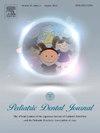Knowledge, perception, attitude, practice and awareness of dentists and dental students about molar-incisor hypomineralization: A systematic review
IF 0.8
Q4 DENTISTRY, ORAL SURGERY & MEDICINE
引用次数: 0
Abstract
Aim
Molar-incisor hypomineralization (MIH) is a developmental enamel defect that presents diagnostic and treatment challenges for dental professionals. Understanding the knowledge, perception, attitude, practice, and awareness of MIH is essential for improving its management in pediatric dentistry. This systematic review evaluates the knowledge, perception, attitude, practice, and awareness of MIH among dentists and dental students.
Methods
A systematic search was conducted across PubMed, Scopus, ScienceDirect, Web of Science, EBSCO, and Google Scholar following PRISMA guidelines. Cross-sectional studies were included, and the methodological quality was assessed using the Joanna Briggs Institute (JBI) checklist.
Results
Out of 2499 identified articles, 38 met the inclusion criteria, comprising 11,129 participants. Data collection was primarily conducted via Email (44.73 %), Google Forms (31.57 %) and direct questionnaire (15.78 %). Most studies assessed knowledge (89.47 %), followed by perception (60.52 %), practice (47.36 %), attitude (34.21 %), and awareness (10.52 %). Pediatric dentists demonstrated higher levels in all domains.
Conclusion
The findings indicate a need for improved education and training on MIH. Dental institutions and regulatory bodies may use this informati-on to enhance curricula and clinical guidelines, promoting better MIH management in pediatric dentistry.
牙医和牙科学生对臼齿-门牙低矿化的认识、感知、态度、实践和意识:系统综述
臼齿-切牙低矿化(MIH)是一种发育性牙釉质缺陷,对牙科专业人员提出了诊断和治疗挑战。了解对MIH的认识、认知、态度、实践和意识,对改善儿童牙科的MIH管理至关重要。本系统综述评估了牙医和牙科学生对MIH的知识、感知、态度、实践和意识。方法按照PRISMA指南,在PubMed、Scopus、ScienceDirect、Web of Science、EBSCO和b谷歌Scholar上进行系统检索。纳入横断面研究,并使用乔安娜布里格斯研究所(JBI)检查表评估方法学质量。结果共纳入2499篇文献,38篇符合纳入标准,共纳入11,129名受试者。数据收集主要通过Email(44.73%)、谷歌Forms(31.57%)和直接问卷(15.78%)进行。大多数研究评估知识(89.47%),其次是感知(60.52%)、实践(47.36%)、态度(34.21%)和意识(10.52%)。儿科牙医在所有领域都表现出更高的水平。结论研究结果表明,需要加强对MIH的教育和培训。牙科机构和监管机构可以利用这些信息来加强课程和临床指南,促进儿童牙科更好的MIH管理。
本文章由计算机程序翻译,如有差异,请以英文原文为准。
求助全文
约1分钟内获得全文
求助全文
来源期刊

Pediatric Dental Journal
DENTISTRY, ORAL SURGERY & MEDICINE-
CiteScore
1.40
自引率
0.00%
发文量
24
审稿时长
26 days
 求助内容:
求助内容: 应助结果提醒方式:
应助结果提醒方式:


